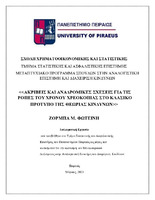Ακριβείς και αναδρομικές σχέσεις για τις ροπές του χρόνου χρεοκοπίας στο κλασικό πρότυπο της θεωρίας κινδύνων

View/
Abstract
Actuarial science is the branch of Economics & Mathematics that applies statistical and mathematical
methods to estimate the risk of uncertainty in future events in insurance, financial investments and other
industries with the purpose of minimizing it. Ruin theory, is a branch of risk theory, which uses the
appropriate mathematical models to describe certain quantities such as the probability of ruin, the
distribution of the surplus before ruin and the deficit at the time of ruin.
In this thesis, the random variable corresponding to the time of ruin 𝑇, will be studied according to the
classical risk model. A critical point of interest is the study of the random variable 𝑇𝑐 (the time of ruin,
given that ruin occurs), which is non-defective, and its density is not known. It is generally difficult to
determine its moments in an explicit form, so approximations are used. For this thesis, we will examine the
moments of the time of ruin and quantities associated with the first three moments of the random variable
𝑇𝑐, such as the variability coefficient and the asymmetry coefficient through examples and diagrams, by
using the mathematical package Mathematica and the R programming language.
Various approximations have been used through time in order to study the properties of ruin probabilities.
Research by Gerber (1987) and Dufresne & Gerber (1988) focuses on formulating expression for the
probability of ruin and the distribution function of the surplus before the time of ruin. There are methods
for calculating and approximating the moments and density of 𝑇𝑐 (Dickson & Waters, 2002), with the most
accurate approach being that of De Vylder (1978). The claim size distribution can be either a combination
of Exponential distributions or Gamma distributions.


